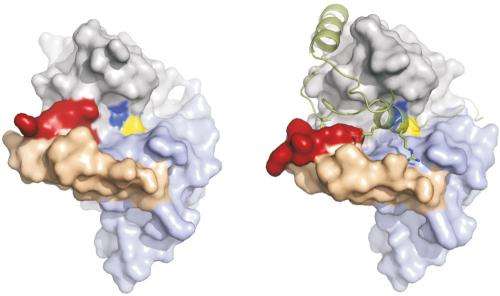Fighting sleeping sickness with X-ray lasers

Structure analysis of the trypanosomal protein Cathepsin B is among the scientific breakthroughs of 2012.
Using the world's most powerful X-ray free-electron laser, an international team of researchers, including scientists of the Max Planck Institute for Medical Research in Heidelberg, has obtained new insight into the structure of a medicinally important protein that may serve as a blueprint for the development of drugs to fight sleeping sickness. Science magazine have chosen the experimental study as one of the top ten scientific breakthroughs of the year.
Sleeping sickness is caused by the unicellular organism Trypanosoma brucei that is transmitted by tsetse flies. The disease kills about 30,000 people word-wide each year. The currently available drugs against the disease are of limited efficacy and can have severe side effects. Moreover, resistance against them is increasing. A promising drug target is the protein Cathepsin B whose enzymatic activity is vital for the parasite's survival. Inhibitors of Cathepsin B need to be highly specific against the trypanosomal variant because it resembles the human form. The featured work provides detailed insight into the structure of trypanosomal Cathepsin B in a natively inhibited form that might serve as a blueprint for the rational design of drugs. The biologically important form of the protein was obtained by a trick: instead of crystallizing the protein in plastic trays in the lab, it was crystallized in vivo in the cells that produced the protein. This approach provides natively modified proteins, but the crystals obtained are tiny.
The use of the X-ray free-electron laser (FEL) at Stanford was essential for the work. Protein structures are typically determined by exposing crystals of the protein to X-rays. Unfortunately, many of the most interesting proteins, such a membrane proteins, do not form crystals of sufficient size for analysis by conventional X-ray sources. Measurements using very tiny crystals have now become feasible thanks to the extreme intensity of FELs whose ultrashort pulse durations outrun most radiation damage effects. It is these properties that allowed structure analysis of the tiny in-vivo grown Cathepsin B crystals. Using a model system, the Heidelberg researchers and their international colleagues had previously validated this new approach using FELs as a tool for structure analysis, an important step in the method development that published in February 2012 in Science. The current featured research demonstrates for the first time FEL use to obtain new biologically important information. The international team shows in detail how the structures of typanosomal and human Cathepsin B differ and how the naturally occurring native inhibitor binds . This may provide new ideas for designing drugs against sleeping sickness.
The team included researchers from the Max Planck Institute for Medical Research, Heidelberg, the Center of Free-Electron Laser Science at Deutschen Elektronen-Synchrotron DESY, the Arizona State University, the Universities of Hamburg, Lübeck, Tübingen, Uppsala and Göteborg, the SLAC National Accelerator Center (USA), the Lawrence Livermore National Laboratory (USA) and the Max Planck Advanced Study Group at the Hamburg Center for Free-Electron Laser Science (CFEL).
More information: Lars Redecke et al. Natively Inhibited Trypanosoma brucei Cathepsin B Structure Determined by Using an X-ray Laser, Science Express, November 29, 2012, DOI: 10.1126/science.1229663
Journal information: Science Express , Science
Provided by Max Planck Society



















